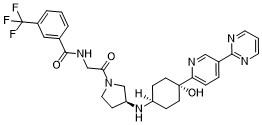PF-4136309 (INCB-8761)
This product is for research use only, not for human use. We do not sell to patients.

For small sizes, please check our retail website as below: www.invivochem.com
| Size | Price | Stock |
|---|---|---|
| 100mg | $650 | In Stock |
| 250mg | $1200 | In Stock |
| 500mg | $1800 | In Stock |
Cat #: V3261 CAS #: 1341224-83-6 Purity ≥ 98%
Description: PF-4136309 (formerly known as INCB8761) is a novel, potent, selective, and orally bioavailable small molecule CCR2 antagonist with IC50 values of 5.2 nM, 17 nM and 13 nM for human, mouse and rat CCR2, respectively.
Top Publications Citing Invivochem Products
Publications Citing InvivoChem Products
Product Promise

- Physicochemical and Storage Information
- Protocol
- Related Biological Data
- Stock Solution Preparation
- Quality Control Documentation
| Molecular Weight (MW) | 568.59 |
|---|---|
| Molecular Formula | C₂₉H₃₁F₃N₆O₃ |
| CAS No. | 1341224-83-6 |
| Storage | -20℃ for 3 years in powder formr |
| -80℃ for 2 years in solvent | |
| Solubility In Vitro | DMSO: ≥ 30 mg/mLr |
| Water: N/Ar | |
| Ethanol: N/A | |
| SMILES Code | O=C(NCC(N1C[C@@H](NC2CCC(C3=NC=C(C4=NC=CC=N4)C=C3)(O)CC2)CC1)=O)C5=CC=CC(C(F)(F)F)=C5 |
| Synonyms | INCB8761; INCB 8761; INCB-8761; PF4136309; PF 4136309; PF-4136309; PF04136309; PF4136309; PF-04136309; |
| Protocol | In Vitro | PF-4136309 is potent in human chemotaxis activity (IC50=3.9 nM) and in the whole blood assay (IC50=19 nM), with IC50 of 16 and 2.8 nM in mouse and rat chemotaxis assays. PF-4136309 is potent in inhibiting CCR2 mediated signaling events such as intracellular calcium mobilization and ERK (extracellular signal-regulated kinase) phosphorylation with IC50 values of 3.3 and 0.5 nM, respectively. In hERG patch clamp assay, PF-4136309 inhibits hERG potassium current with an IC50 of 20 μM. PF-4136309 is not a cytochrome P450 (CYP) inhibitor, with IC50 values of >30 μM against five major CYP isozymes CYP1A2, CYP2C9, CYP2C19, CYP2D6, and CYP3A4. Moreover, PF-4136309 is not a CYP inducer at concentrations up to 30 μM |
|---|---|---|
| In Vivo | PF-4136309 (2 mg/kg) exhibits a moderate half-life in both species after iv administration (2.5 and 2.4 h). When administered orally, PF-4136309 (10 mg/kg) is absorbed rapidly, with peak concentration time (Tmax) at 1.2 h for rats and 0.25 h for dogs. A similar half-life is observed in both species between iv dosing and po dosing. PF-4136309 is well absorbed, with an oral bioavailability of 78% in both species |
These protocols are for reference only. InvivoChem does not
independently validate these methods.
| Solvent volume to be added | Mass (the weight of a compound) | |||
|---|---|---|---|---|
| Mother liquor concentration | 1mg | 5mg | 10mg | 20mg |
| 1mM | 1.7587 mL | 8.7937 mL | 17.5874 mL | 35.1747 mL |
| 5mM | 0.3517 mL | 1.7587 mL | 3.5175 mL | 7.0349 mL |
| 10mM | 0.1759 mL | 0.8794 mL | 1.7587 mL | 3.5175 mL |
| 20mM | 0.0879 mL | 0.4397 mL | 0.8794 mL | 1.7587 mL |
The molarity calculator equation
Mass(g) = Concentration(mol/L) × Volume(L) × Molecular Weight(g/mol)
Mass
=
Concentration
×
Volume
×
Molecular Weight*
The dilution calculator equation
Concentration(start)
×
Volume(start)
=
Concentration(final)
×
Volume(final)
This equation is commonly abbreviated as: C1 V1 = C2 V2
Concentration(start)
C1
×
Volume(start)
V1
=
Concentration(final)
C2
×
Volume(final)
V2
Step One: Enter information below
Dosage mg/kg
Average weight of animals g
Dosing volume per animal µL
Number of animals
Step Two: Enter the in vivo formulation
%DMSO
+
%
+
%Tween 80
+
%ddH2O
Calculation Results:
Working concentration:
mg/ml;
Method for preparing DMSO master liquid:
mg
drug pre-dissolved in
µL
DMSO(Master liquid concentration
mg/mL)
,Please contact us first if the concentration exceeds the DMSO solubility of the batch of drug.
Method for preparing in vivo formulation:
Take
µL
DMSO master liquid, next add
µL
PEG300, mix and clarify, next add
µL
Tween 80,mix and clarify, next add
µL
ddH2O,mix and clarify.
Note:
- (1) Please be sure that the solution is clear before the addition of next solvent. Dissolution methods like vortex, ultrasound or warming and heat may be used to aid dissolving.
- (2) Be sure to add the solvent(s) in order.




































